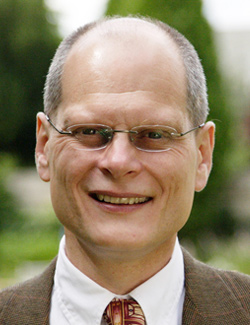It has been really rewarding to see the impact and reach of the society’s work in advocacy.
Technology is so central to modern life that public policies must be informed by the best available science. Thus OSA’s international activities supporting advocacy for our field are increasingly important at a time when technological progress is often taken for granted, and when the advice of experts is frequently undervalued. It has been really rewarding to see the impact and reach of the society’s work in advocacy.
In May of this year, I was delighted to present the OSA Advocate of Optics Recognition to Carol Monaghan, MP, at the Scottish University–Stanford University Annual Symposium in Glasgow. Carol is a member of the U.K. Parliament and sits on the House of Commons Science and Technology Committee, one of two major governmental committees with a remit to ensure that U.K. policy and governmental decision-making is supported by sound scientific evidence and long-term strategy. She was recognized for her “public policy leadership and efforts in support of the advancement of the science of light.”
A crucial part of our professional activities is getting involved in working with the public, with government and across all OSA constituencies to raise awareness of science and technology’s value for the world. That includes helping to develop policies that lead to the responsible application and use of science, and to argue for and justify the use of public funds to support research and development to improve people’s lives.
OSA has grown its support for member-led advocacy over the past decade and has had some stunning successes. One recent example is legislation introduced in both houses of the U.S. Congress to create a National Quantum Initiative, which would support increased research and development in quantum technologies. Two OSA members, Mike Raymer and Christopher Monroe, have been at the forefront of that engagement, supported by the U.S. National Photonics Initiative, of which OSA is a co-founder and funder. Their work builds on similar initiatives in other countries and regions worldwide in which OSA members have likewise played a significant advocacy role.
As another example, OSA is sponsoring the Bipartisan Civic Engagement Initiative in the United States this fall, during the midterm congressional elections. This initiative will support young scientists in their efforts to raise awareness, among congressional candidates and in local communities, of the health, economic and societal benefits of public- and private-sector research.
A sign of OSA’s global reach is still another effort, the International Photonics Advocacy Coalition (IPAC), led by 2009 OSA President Thomas Baer. IPAC’s goals are to educate policymakers about photonic technologies, beginning with their application to environmental monitoring; to advocate for resources for international initiatives relating to optics and photonics; and to generate global collaboration and coordination across industry, government and academia to advance knowledge of photonics technologies.
As OSA continues to expand its staff presence around the world, I hope that it will be in a position to increase support for local advocacy for optics and photonics, as well as helping to link up the efforts of different nations to tackle some of the global challenges of the 21st century. And I hope that you, as OSA members, will play an active role to ensure that our field is recognized for providing or facilitating solutions to these challenges.
—Ian Walmsley,
OSA President

